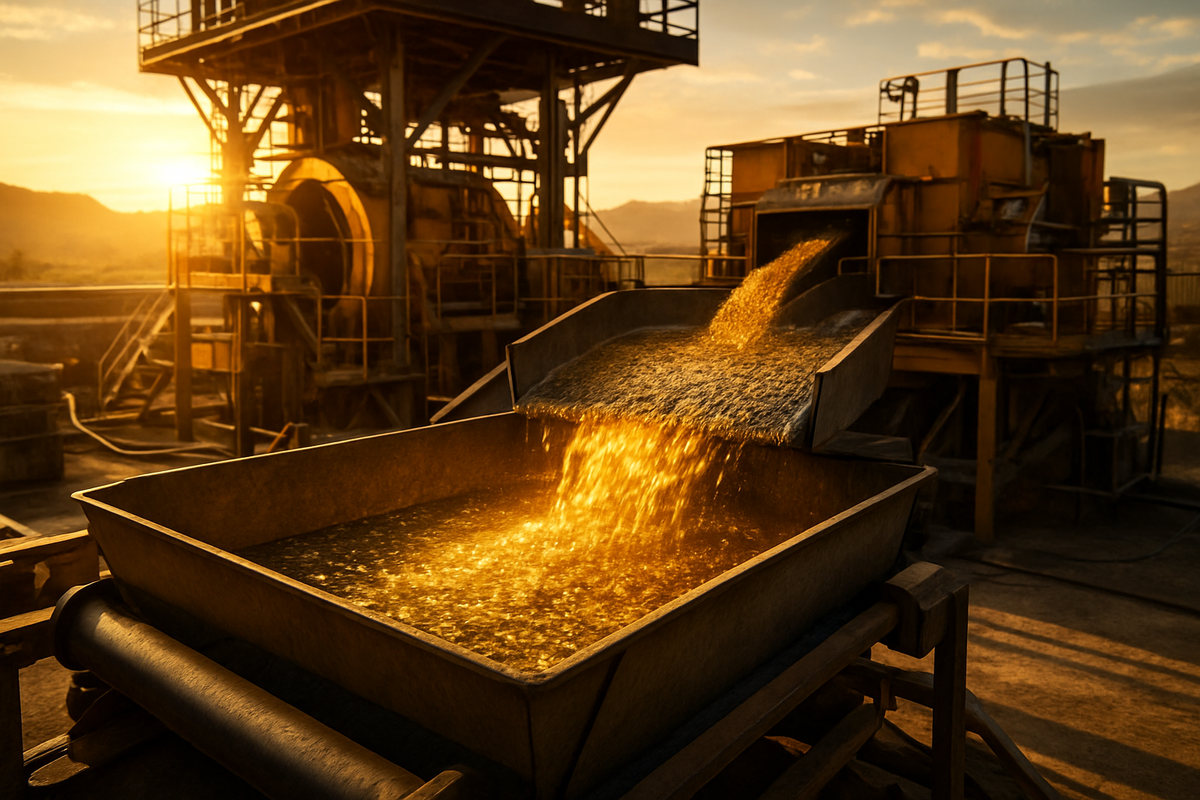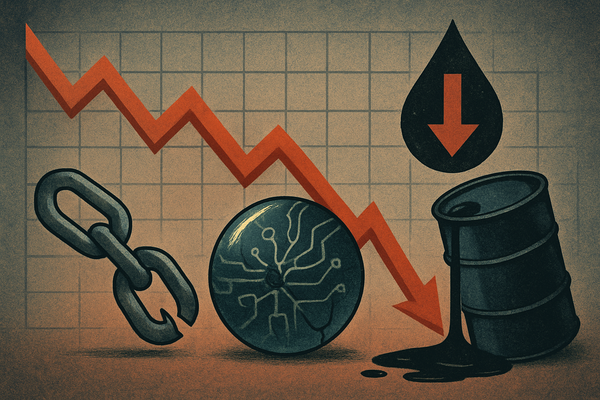Pinnacle Silver and Gold Strikes Gold with 95% Recoveries at El Potrero, Bolstering Project Economics

Pinnacle Silver and Gold Corp. (OTC: PSVGF) has announced groundbreaking preliminary metallurgical test results from its El Potrero gold-silver project in Durango, Mexico, revealing an exceptional average gold recovery rate of 95.09%. This highly encouraging outcome, reported on October 28, 2025, signals a significant de-risking of the project and provides a substantial boost to its economic viability and the company's future prospects. The remarkable recovery rates suggest that the El Potrero project is well-positioned for efficient gold extraction, potentially leading to robust cash flow generation and accelerating its path to production. This news is expected to significantly enhance investor confidence and validate the company's strategy of fast-tracking past-producing mines back into operation.
Groundbreaking Recoveries De-Risk El Potrero, Paving Way for Accelerated Production
The preliminary scoping metallurgical tests, conducted at the SGS Lab in Durango, Mexico, involved three samples taken from the mineralized zone within the historic Pinos Cuates underground mine. The process included grinding, bottle roll cyanide leach tests, and gravity tests. The grinding process achieved a target particle size of 80% passing 270 mesh (53 microns). The standout results came from the bottle roll cyanide leach tests, which delivered individual gold recoveries of 92.81%, 95.68%, and 96.79%, culminating in the impressive average of 95.09%. Silver recoveries, while lower and more variable (averaging 54.68%), indicate a need for further optimization, potentially through extended leach times. Gravity tests also showed variable gold recoveries, ranging from 29.1% to 76.38%, with one sample exhibiting a high 76.38% recovery, likely due to a greater presence of free gold. Reagent consumption for sodium cyanide and calcium oxide remained within expected preliminary ranges. Pinnacle's President & CEO, Robert Archer, expressed satisfaction, noting these results were achieved with simple baseline parameters and without optimization, suggesting further potential for improvement.
The journey to these significant metallurgical results has been a dynamic one for Pinnacle Silver and Gold (OTC: PSVGF). The company initiated its involvement with El Potrero on October 28, 2024, by signing a Letter of Intent to acquire a staged option for up to a 100% interest. This was followed by comprehensive technical due diligence and the filing of an NI 43-101 Technical Report by January 29, 2025. By February 25, 2025, Pinnacle had successfully closed an oversubscribed non-brokered private placement and completed the staged option acquisition. Fieldwork commenced in March 2025, building on earlier non-systematic sampling that had already hinted at the high-grade nature of the gold-silver mineralization. Subsequent months saw a series of positive announcements, including high-grade gold and silver mineralization from systematic underground channel sampling at the Pinos Cuates mine in June and July 2025, and the definition of high-grade mineralization in the Dos de Mayo Mine by September 2025. Strong investor demand, evidenced by an oversubscribed financing round in early August 2025, underscored growing market confidence. The company further bolstered its Mexican management team in October 2025, appointing Carlos Castro Villalobos as Project Manager and confirming Jorge Ortega as Exploration Manager, setting the stage for accelerating development. The metallurgical test results, announced on October 28, 2025, are a culmination of these efforts, validating the project's potential.
Key players instrumental in this development include Robert Archer, President & CEO of Pinnacle Silver and Gold (OTC: PSVGF), whose extensive experience from Great Panther Silver (TSX: GPR, NYSEAMERICAN: GPL) is guiding the project. Carlos Castro Villalobos, the newly appointed Project Manager, brings over 45 years of mining engineering experience in Mexico, including leadership roles at companies like Industrias Peñoles (BMV: PE&OLES) and Great Panther. Jorge Ortega, P. Geo, serves as the Qualified Person and Exploration Manager, overseeing the geological aspects. The SGS Lab in Durango, Mexico, was responsible for conducting the critical metallurgical tests. Investors, particularly those who participated in the oversubscribed financing rounds, are significant stakeholders, demonstrating their belief in the project's prospects. Local communities are also important stakeholders, with Pinnacle aiming to maintain positive relationships, drawing on Archer's prior experiences in the region.
While specific immediate stock price movements following the October 28, 2025, announcement are still unfolding, past announcements of high-grade assay results from El Potrero have consistently led to positive share price uplifts for Pinnacle Silver and Gold (OTC: PSVGF). The oversubscription of the August 2025 financing round, driven by strong assay results, clearly indicated robust investor sentiment leading into this metallurgical announcement. The positive gold recovery results, especially in conjunction with existing plant infrastructure on site, are expected to be viewed very favorably by the market, aligning with the company's stated strategy to fast-track the project to production and potentially attracting further investment interest and capital for future development phases.
El Potrero's High Recoveries: A Game Changer for Pinnacle and Mexican Mining Sector
The exceptional 95.09% average gold recoveries at El Potrero are set to significantly bolster Pinnacle Silver and Gold (OTC: PSVGF). These robust metallurgical results are a critical de-risking event, enhancing the project's economic viability and making it far more attractive to investors. Higher recovery rates directly translate to more gold ounces produced from a given amount of ore, leading to increased revenue per tonne, improved profit margins, and stronger free cash flow. This success is expected to elevate Pinnacle's project valuation and overall market capitalization, as projects with demonstrated high recoveries are typically favored by investors. Furthermore, the strong technical validation can accelerate the project's development, potentially enabling the company to bring the past-producing mine back into production within two to three years, leveraging existing infrastructure at a relatively low cost. This aligns perfectly with Pinnacle's "fast-track" strategy and strengthens investor confidence in its ability to execute its business model in Mexico's prolific Sierra Madre Occidental.
The positive news from El Potrero is also likely to create a ripple effect across the broader gold and silver mining sector in Mexico, particularly for junior and mid-tier companies operating in the same geological belt. Companies with similar high-grade, low-sulphidation epithermal vein systems could see a positive uplift. Potential "winners" might include Mithril Silver and Gold, which operates the Copalquin property in Durango, Mexico. If Copalquin's mineralization exhibits similar characteristics, investors might re-evaluate its potential recovery rates, boosting its perceived value. Similarly, Tocvan Ventures (CSE: TOC), advancing the Gran Pilar Gold-Silver Project in Sonora, Mexico, could benefit from increased investor interest if its project also demonstrates high-grade epithermal characteristics. Defiance Silver Corp. (TSXV: DEF, OTCQX: DNCVF), with its various Mexican projects, and Kootenay Silver Inc. (TSXV: KTN), actively developing several major silver projects in Mexico, could also experience indirect benefits from a renewed positive sentiment for precious metals exploration and development in the country.
Conversely, companies with lower gold recovery rates from comparable deposits in Mexico, or those struggling to demonstrate clear economic viability, might find themselves under increased scrutiny. Pinnacle's high benchmark could put pressure on these companies to optimize their processes or face investor skepticism. For instance, Guanajuato Silver (TSXV: GSVR), which operates the Topia mine (250 tpd) geographically close to El Potrero, could face questions if its gold recovery rates are significantly lower, highlighting a comparative disadvantage in operational efficiency. Similarly, Luca Mining (TSXV: LUCA), operating the Tahuehueto Au-Ag-Cu-Pb-Zn Mine (1,000 tpd) in proximity, might also find its project's efficiency questioned if its gold recoveries do not stand up favorably to Pinnacle's results, even though Tahuehueto is a polymetallic mine. This event sets a new standard for gold recovery expectations in the region, potentially making it harder for projects with less efficient metallurgy to attract capital and maintain investor interest.
The Wider Significance of El Potrero's High Recoveries
Pinnacle Silver and Gold's (OTC: PSVGF) announcement of 95% average gold recoveries at its El Potrero project in Durango, Mexico, holds significant wider implications for the gold mining industry, particularly in the region. These high recovery rates are paramount in modern mining, translating directly to increased profitability, optimized resource utilization, and reduced operational costs per ounce, especially as high-grade deposits become scarcer globally. The fact that these preliminary results were achieved using simple baseline parameters without optimization suggests the inherent treatability of the El Potrero ore, setting a high benchmark for efficiency and potentially influencing how other projects in the region are evaluated. This success aligns with broader industry trends emphasizing enhanced ore processing techniques, technological advancements, and a growing focus on sustainability and environmental stewardship by maximizing value from mined material and reducing the overall mining footprint.
The ripple effects of this achievement are likely to be felt across the competitive landscape. Competitors operating in similar geological settings, particularly within Mexico's Sierra Madre Occidental, may face increased pressure to achieve comparable recovery rates. This could spur greater investment in metallurgical testing, process optimization, and the adoption of advanced recovery technologies across the sector. Pinnacle's success could also attract more investment and potential partnerships, including those offering specialized processing technologies or capital, leading to increased collaboration in research and development, especially for optimizing silver recovery at El Potrero. Furthermore, demand for related supply chain partners, such as those providing reagents and equipment for enhanced ore processing, might see a surge.
From a regulatory and policy perspective, Mexico's mining sector has seen varying governmental stances. However, projects demonstrating high efficiency and reduced environmental impact, like El Potrero with its exceptional recovery rates, might find a more streamlined path through regulatory processes. A "more mining-friendly administration" in Mexico, emphasizing responsible expansion, could favor such projects. High recovery rates also bolster a company's case for environmental responsibility by maximizing resource extraction and minimizing waste per unit of metal, potentially influencing future regulatory frameworks towards more efficient and sustainable operations. Strong community engagement, a focus for companies restarting past-producing mines, can also be bolstered by demonstrating clear economic viability and the potential for local benefits.
Historically, advancements in recovery processes have fundamentally reshaped the mining industry. The introduction of the cyanidation process in the late 19th century dramatically improved gold recovery from lower-grade and refractory ores, opening up vast new reserves. Similarly, flotation technology in the early 20th century revolutionized the recovery of metals from complex sulphide ores. More recently, bio-oxidation and pressure oxidation have become critical for unlocking refractory gold ores. While Pinnacle's achievement at El Potrero doesn't represent a brand-new technology, it exemplifies the successful application and optimization of established metallurgical understanding to achieve near-optimal recovery for a specific deposit, pushing the boundaries of what is considered excellent performance through refined existing techniques. This continuous progression towards higher efficiency remains a cornerstone of the precious metals sector.
The Road Ahead: El Potrero's Path to Production and Beyond
Following the highly encouraging 95.09% average gold recoveries at El Potrero, Pinnacle Silver and Gold (OTC: PSVGF) is poised to accelerate its "cash-flow-first" business model. In the short term, the company will prioritize further detailed metallurgical and mineralogical work to fully understand gold and silver occurrences and optimize recovery processes, particularly for the more variable silver. Concurrently, efforts will focus on resource delineation through systematic underground and surface mapping, sampling, and initiating drilling programs to establish a robust resource base. Crucially, the rehabilitation of existing underground workings and the refurbishment of the 100-tonne-per-day processing plant, which benefits from being a past-producing site, will be fast-tracked at a relatively low cost. The recent strengthening of the Mexican management team, including the appointment of Carlos Castro Villalobos as Project Manager, underscores the company's commitment to expediting these critical steps, with the aim of securing permits within two to three years.
Long-term possibilities for El Potrero center on a phased approach to growth, driven by initial production. Pinnacle's strategy is to achieve small-scale, high-margin production (targeting ~100 TPD) as quickly as possible to generate cash flow. This cash flow will then be reinvested into further exploration to expand the resource base along the known 500-meter strike length and beyond, leveraging the project's significant exploration upside, as it has not seen modern systematic exploration for nearly 40 years. The existing plant is considered scalable, allowing for future expansion as resources grow. The company also aims to increase its ownership in El Potrero from an initial 50% to potentially 100% through subsequent development phases funded by cash flow, echoing CEO Robert Archer's successful "Great Panther playbook" of building through cash flow and strategic acquisitions in the Americas.
Potential strategic pivots or adaptations might include dedicating more resources to developing a tailored processing flow sheet to significantly improve silver recovery, which could substantially enhance overall project economics. Should a larger-scale resource be identified that requires substantial capital beyond internal cash flow, Pinnacle might explore strategic partnerships or joint ventures with larger mining entities. Flexibility in production scale, driven by market conditions and resource definition, could also be an adaptation. Market opportunities are strong, fueled by favorable precious metal prices and a demand for new, efficient production in Mexico. El Potrero's underexplored potential and location in the mining-friendly state of Durango present significant upside. However, challenges remain, including securing initial financing for junior miners, navigating Mexico's evolving regulatory environment (e.g., new concessions freeze, water permits), and managing competition for skilled labor.
Several scenarios and outcomes are possible. The most likely scenario, based on the company's stated strategy, is successful development and production, leading to consistent cash flow that funds further exploration, expansion, and increased ownership, with minimal shareholder dilution. Alternatively, the project's proven metallurgy and high-grade potential could make it an attractive acquisition target for a larger company, offering shareholders a significant premium. Conversely, unforeseen geological complexities, permitting delays, or higher-than-expected costs could lead to delays or increased capital requirements, potentially necessitating further equity financings. While less probable given early results, if subsequent drilling does not confirm sufficient economic mineralization, the project's viability could be jeopardized, requiring a re-evaluation of its future.
El Potrero's High Recoveries: A Solid Foundation for Pinnacle's Future
Pinnacle Silver and Gold Corp.'s (OTC: PSVGF) announcement of a 95.09% average gold recovery rate from preliminary metallurgical tests at its El Potrero project in Durango, Mexico, represents a pivotal moment for the company and a significant technical validation for the project. The tests, conducted on samples from the historic Pinos Cuates underground mine, confirm that the gold mineralization is highly amenable to conventional cyanide leaching, with rapid dissolution kinetics and exceptional recovery rates. While gold recoveries were stellar, averaging over 95%, silver recoveries were more variable at 54.68%, indicating an area for future optimization. The low reagent consumption further underscores the project's potential for efficient and cost-effective processing.
The key takeaways from this development are clear: El Potrero's high gold amenability de-risks the processing aspect of the project, providing a strong foundation for its economic viability. Pinnacle's strategic business model of fast-tracking a past-producing mine back into production, leveraging existing infrastructure like the 100 tpd plant and rehabilitated underground workings, is significantly bolstered. The project's favorable location within Mexico's prolific Sierra Madre Occidental, surrounded by other operating mines, coupled with extensive underexplored potential, points to substantial resource expansion opportunities. Furthermore, the strengthening of Pinnacle's Mexican management team positions the company for efficient execution of its development plans.
Moving forward, the market environment for precious metals appears increasingly favorable, offering a positive backdrop for El Potrero. Pinnacle's "cash-flow-first" strategy, aimed at generating early revenue to fund further development and reduce reliance on dilutive equity financings, is a prudent approach in the junior mining sector. The project's existing infrastructure and strategic location provide inherent cost advantages and contribute to a more streamlined development pathway. The significance of these high recoveries lies in their ability to fundamentally de-risk the project, positioning El Potrero as a potentially robust near-term production asset for Pinnacle. This success could establish Pinnacle as a model for redeveloping past-producing mines in Mexico, demonstrating the value of modern exploration and processing techniques in historically rich mining districts and contributing to local economies.
For investors, the coming months will be crucial. Watch closely for updates on permitting progress for plant refurbishment and mining operations, as timely approvals are essential. Details on the costs and timelines associated with rehabilitating the plant, along with results from planned drilling programs, will be vital for defining and expanding the mineral resource. Investors should also look for new NI 43-101 compliant resource estimates or economic studies, such as a Preliminary Economic Assessment (PEA). Any announcements regarding financing, particularly non-dilutive options like off-take agreements, will be important. Finally, progress on silver recovery optimization and the company's projected timeline for initial gold production will be key indicators of the project's overall advancement and potential for cash flow generation.
This content is intended for informational purposes only and is not financial advice



